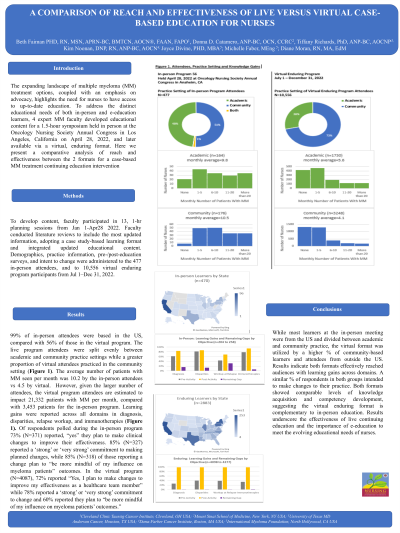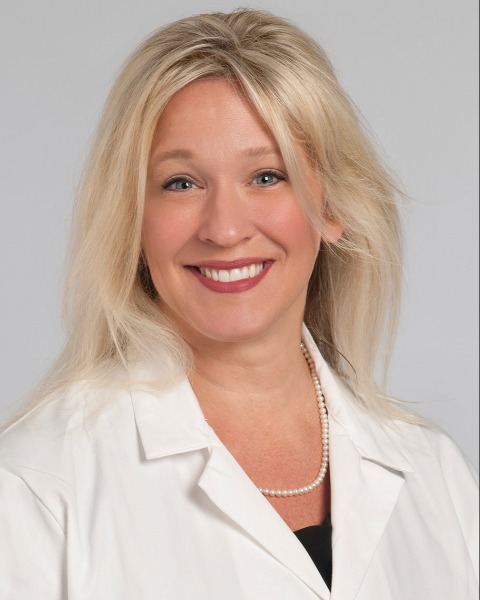Nursing Symposium
Poster Session 1
NSP-07: A Comparison of Reach and Effectiveness of Live versus Virtual Case-Based Education for Nurses
Wednesday, September 27, 2023
1:30 PM - 2:30 PM EEST


Beth Faiman, PhD, MSN, APN-BC,BMTCN, AOCN, FAAN, FAPO
Nurse Practitioner and Researcher
Cleveland Clinic Taussig Cancer Institute, Department of Hematology and Medical Oncology
Cleveland, Ohio, United States
Introduction: The expanding landscape of multiple myeloma (MM) treatment options, coupled with an emphasis on advocacy, highlights the need for nurses to have access to up-to-date education. To address the distinct educational needs of both in-person and e-education learners, 4 expert MM faculty developed educational content for a 1.5-hour symposium held in person at the Oncology Nursing Society Annual Congress in Los Angeles, California on April 28, 2022, and later available via a virtual, enduring format. Here we present a comparative analysis of reach and effectiveness between the 2 formats for a case-based MM treatment continuing education intervention.
Methods: To develop content, faculty participated in 13, 1-hr planning sessions from Jan 1-Apr28 2022. Faculty conducted literature reviews to include the most updated information, adopting a case study-based learning format and integrated updated educational content. Demographics, practice information, pre-/post-education surveys, and intent to change were administered to the 477 in-person attendees, and to 10,556 virtual enduring program participants from Jul 1–Dec 31, 2022.
Results: The live program attendees were split between academic and community practice settings while more virtual attendees practiced in the community. The average number of patients with MM seen per month was 10.2 in-person vs 4.5 virtual. The virtual program attendees were estimated to impact 21,332 patients with MM per month, compared with 3,453 patients for the in-person program. Learning gains were reported across all domains in diagnosis, disparities, relapse workup, and immunotherapies (Figure 1). Of respondents polled during the in-person program 73% (N=371) reported, “Yes” they plan to make clinical changes to improve their effectiveness. 85% (N=327) reported a ‘strong’ or ‘very strong’ commitment to making planned changes, while 85% (N=318) of those reported a change plan to “be more mindful of my influence on myeloma patients” outcomes. In the virtual program (N=4087), 72% reported “Yes, I plan to make changes to improve my effectiveness as a healthcare team member” while 78% reported a ‘strong’ or ‘very strong’ commitment to change and 60% reported they plan to “be more mindful of my influence on myeloma patients’ outcomes.”
Conclusions: While most learners at the in-person meeting were from the US and divided between academic and community practice, the virtual format was utilized by a higher % of community-based learners and attendees from outside the US. Results indicate both formats effectively reached audiences with learning gains across domains. A similar % of respondents in both groups intended to make changes to their practice. Both formats showed comparable levels of knowledge acquisition and competency development, suggesting the virtual enduring format is complementary to in-person education. Results underscore the effectiveness of live continuing education and the importance of e-education to meet the evolving educational needs of nurses.
Methods: To develop content, faculty participated in 13, 1-hr planning sessions from Jan 1-Apr28 2022. Faculty conducted literature reviews to include the most updated information, adopting a case study-based learning format and integrated updated educational content. Demographics, practice information, pre-/post-education surveys, and intent to change were administered to the 477 in-person attendees, and to 10,556 virtual enduring program participants from Jul 1–Dec 31, 2022.
Results: The live program attendees were split between academic and community practice settings while more virtual attendees practiced in the community. The average number of patients with MM seen per month was 10.2 in-person vs 4.5 virtual. The virtual program attendees were estimated to impact 21,332 patients with MM per month, compared with 3,453 patients for the in-person program. Learning gains were reported across all domains in diagnosis, disparities, relapse workup, and immunotherapies (Figure 1). Of respondents polled during the in-person program 73% (N=371) reported, “Yes” they plan to make clinical changes to improve their effectiveness. 85% (N=327) reported a ‘strong’ or ‘very strong’ commitment to making planned changes, while 85% (N=318) of those reported a change plan to “be more mindful of my influence on myeloma patients” outcomes. In the virtual program (N=4087), 72% reported “Yes, I plan to make changes to improve my effectiveness as a healthcare team member” while 78% reported a ‘strong’ or ‘very strong’ commitment to change and 60% reported they plan to “be more mindful of my influence on myeloma patients’ outcomes.”
Conclusions: While most learners at the in-person meeting were from the US and divided between academic and community practice, the virtual format was utilized by a higher % of community-based learners and attendees from outside the US. Results indicate both formats effectively reached audiences with learning gains across domains. A similar % of respondents in both groups intended to make changes to their practice. Both formats showed comparable levels of knowledge acquisition and competency development, suggesting the virtual enduring format is complementary to in-person education. Results underscore the effectiveness of live continuing education and the importance of e-education to meet the evolving educational needs of nurses.
